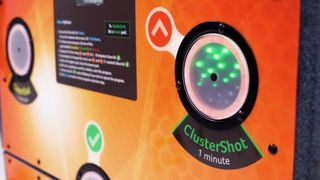How To Use The CardioWall – The Most Fun Piece Of Equipment In The Gym
No-one ever enjoyed a treadmill session this much

The only way you’re likely to keep exercising is if you enjoy doing it, or at least appreciate the feelgood endorphins that flood your body after a workout. So it makes sense to spend time trying every piece of equipment in the gym until you find the one you like the most.
Of course it makes even more sense to go straight to the most enjoyable one. And that’s the CardioWall, which is popping up in more and more gyms including branches of Fitness First and Bannatyne’s.
The CardioWall is basically a game. Remember that. We’ll go on to tell you all the ways it helps improve your fitness, but at its core, it’s a highly addictive game where you tap lights on a wall as fast as you can, aiming to set ever higher totals. Any health benefits are a bonus.
We asked Simon Heap – founder of Rugged Interactive, which sells a variety of CardioWalls – for all the info on how and why you should give them a try.
How does the CardioWall improve fitness?
“CardioWalls are exceptionally good at working the whole body and, uniquely, the brain too. They deliver mindfulness and cardio in combination with high-intensity interval training (HIIT), as well as improving your balance, core strength, reactions and peripheral vision.”
Are they a good form of training for certain sports in particular?
“You can improve in any sport that benefits from improved balance and peripheral vision. We’ve had customers from Premier League football clubs, F1 teams, hockey and athletics, but ultimately any sport can benefit.”
RECOMMENDED: The Four-Week Lean Muscle Workout Plan
Get the Coach Newsletter
Sign up for workout ideas, training advice, reviews of the latest gear and more.
Should you hold weights while using the wall to make it harder?
“We recommend the use of our own soft weights, but Pilates balls, sparring mitts, medicine balls and even bare hands all work well, and each brings different benefits.”
What would a typical session on the CardioWall be?
“A beginner CardioWall user might want to begin with a reaction session – called Chaser in CardioWall vocab – then do a nice steady ClearOut, working up and down the CardioWall, and finish with ClusterShot, which is a high-energy thrash.
“Remember it’s not about power. It’s about accuracy, speed and balance – not hitting or pushing hard, just being deliberate.
“Some users also like to use the CardioWall at the centre of a circuit training session with other exercises. Our motor-racing partners like to track deterioration in performance over time, so they’ll start with the CardioWall, then do weights or an intense cardio interval, then go back to the CardioWall to see if they can achieve the same performance.”

Nick Harris-Fry is a journalist who has been covering health and fitness since 2015. Nick is an avid runner, covering 70-110km a week, which gives him ample opportunity to test a wide range of running shoes and running gear. He is also the chief tester for fitness trackers and running watches, treadmills and exercise bikes, and workout headphones.
